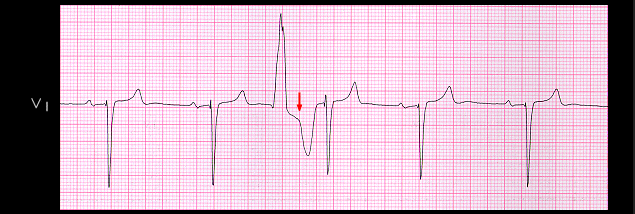Although ventricular premature beats are most often followed by fully compensatory pauses and atrial premature beats are most often followed by less than fully compensatory pauses, there is considerable variability in these “rules”. For instance, if the sinus rate is slow enough, the sinus P wave which follows a ventricular premature beat may be able to conduct to the ventricles because the AV node and ventricular conduction system will had time to at least partially recover their excitability following the retrograde penetration of the premature beat into these structures. Usually the PR interval of this post extrasystolic beat will be prolonged because the AV node and/or conducting system will still be partially refractory. Such premature beats are referred to as being “interpolated” between two conducted sinus beats.

This tracing illustrates an interpolated ventricular premature beat. The sinus PP interval is 1.24 seconds (sinus rate 48) and the PR interval is 0.18 seconds. The ventricular premature beat is followed by a P wave that is difficult to see because it is contained within the ST segment and T wave of the premature beat (arrow) but it is still able to conduct to the ventricles, albeit with a prolonged PR interval (0.36 seconds).
